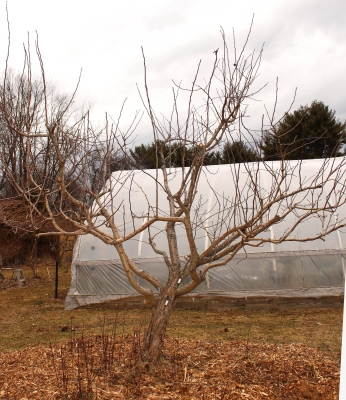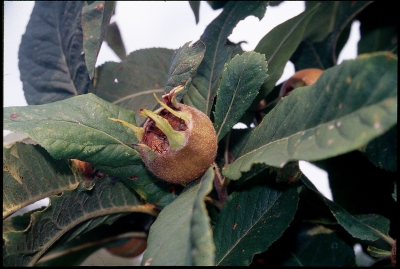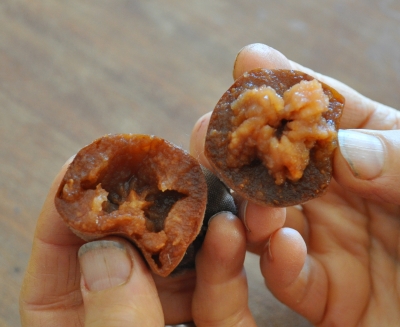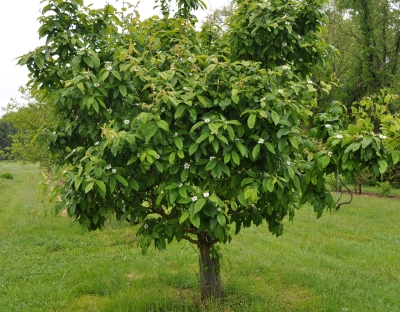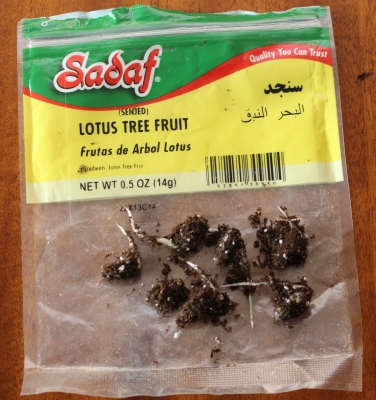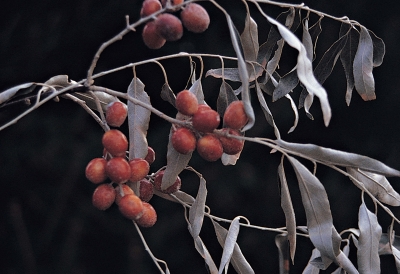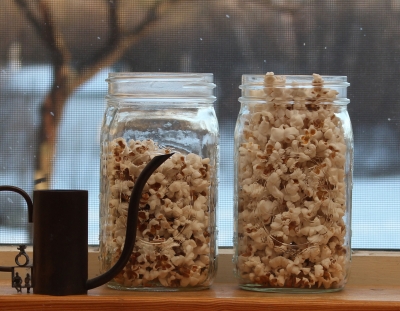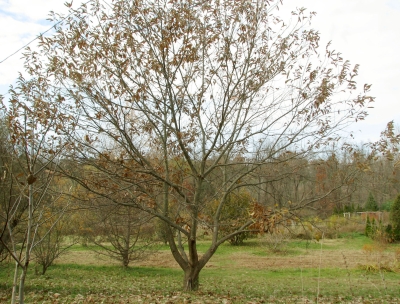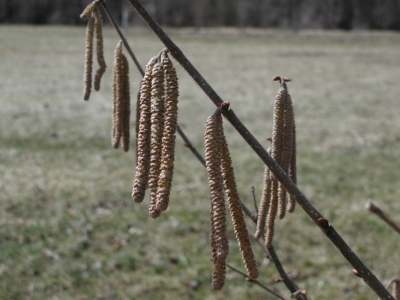POPPING, PRUNING, AND EATING
/3 Comments/in Fruit/by Lee Reich
Popcorn Gets Bigger, But Medlar Is Still Ugly (Not To Me)
A couple of weeks ago I wrote about increasing the poppability of my home-grown popcorn by exposing the kernels to the vapor of a saturated salt solution. Pennsylvania Dutch Butter Flavored popcorn, a variety that usually pops fairly well, popped to 1/3 greater volume.
This week Pink Pearl, a variety that’s not usually a very good popper, underwent testing. The result: No effect of the treatment; both the treated and untreated batches popped pretty well. Was it the change in the weather, stronger hints of spring? Perhaps. (Previously, I pointed out how cold weather outside turns indoor air drier, perhaps too dry for good popcorn popping.) At any rate, Pink Pearl was tasty.
Medlar Teaches How To Prune A Fruit Plant
The weather change also had the effect of drawing me outdoors more — for pruning. Looking at my medlar tree’s branches going every which way, I scratched my head (figuratively) wondering where to start, what to cut.
Medlar is a fruit tree (more on medlar later), and the first step in pruning any fruit tree is attending to light. Light provides the energy for photosynthesis which translates into flavorful fruits. The goal is to let every branch bathe in sunlight, which also helps thwart potential disease problems.
So I stopped scratching my head and started with a few dramatic pruning cuts, lopping some of the larger limbs back to their origins. Medlar has a naturally spreading growth habit, so cuts were aimed at removing limbs trying to fill in and shade the the center of the tree. I wanted a whorl of branches reaching up and out.
Next to go were dead, diseased, and broken branches. I saw remnants of cicada damage from two years ago. Away with most of those stems also.
For the next cuts, you have to know how a particular kind of fruit tree bears fruit. At one extreme are peaches. They bear only on one-year-old stems so need aggressive pruning each year to stimulate new shoots that become next year’s bearing, one-year-old stems. At the other extreme are apple and pear trees. They bear fruit on long-lived spurs, which are stumpy, branching stubs that develop on older limbs, so relatively little pruning is needed.
Medlar’s bearing habit lies somewhere between those two extremes. I shortened a few very old branches to invigorate them with new growth.
On most fruit trees, drooping branches make poorer fruit. Probably for medlar also. So off came the drooping branches, either back to non-droopy portions or to their origin.
Finally, some detail work: shortening or removing those vigorous, vertical shoots called watersprouts; thinning out smaller areas of congested branches; removing stems growing too close to where major limbs exit the trunk; and lopping down root sprouts growing at or near ground level from the rootstock.
Besides fruit, medlar offers beauty. Part of the beauty is the craggy shape of the tree, its muscular limbs clothed in golden brown bark. I stepped back to admire the tree and my work after pruning. If I’ve done a good job, the tree looks happily ready to bask in light and air and, because the major cuts removed limbs at the origin, hardly looks like it’s been pruned.
Medlar Teaches To Eat With Your Tongue, Not Your Eyes
Medlar is a fruit whose popularity peaked in the Middle Ages. Charlemagne was a fan, a big fan who demanded the tree be planted in every town he conquered.
Despite its popularity, even in the Middle Ages, the fruit has often been described disparagingly — for its appearance, though, not its flavor. The fruits resemble small, russeted apples, tinged dull yellow or red, with their calyx ends (across from the stems) flared open. “Open-arse” was the name Chaucer chose. A more recent writer described medlar as “a crabby-looking, brownish-green, truncated, little spheroid of unsympathetic appearance. “ (All recounted, along with information about growing, procuring, and eating medlars in the chapter on medlar in my book Uncommon Fruits for Every Garden.)
Oh, one more quirk about medlar: The fruit, rock hard at harvest, needs to be bletted before eating. This means gently setting it on a counter in a cool room for a couple of weeks, or more, depending to the temperature, during which time the fruit’s interior turns to brown mush. Ugly to look at, but the flavor has a refreshing briskness with winy overtones, like old-fashioned applesauce laced with cinnamon. Between the fruits’ appearance and their need for bletting, you’ll never find medlars for sale on a supermarket shelf.
Perhaps the fruit is ugly. The tree is not. I already mentioned the attractive form and color of the limbs. The white flowers, opening here in May, are like those of a wild rose, each one enhanced because its late opening gets a backdrop of a whorl of already unfurled, dark, green leaves. The tree grows only 8 or 10 feet high and wide and will fruit without another pollinator, so is perfect for a small yard. No need to decide whether to plant a fruit tree or an ornamental tree; medlar is both trees in one.
ELUSIVE AZURE AND FRUIT
/2 Comments/in Flowers, Fruit/by Lee ReichToo Hot Here For These Gems, But Maybe I Can Trick Them
It was decades ago that Norman — gardener, orchid expert, one-time cattle farmer, and lawyer — described to me his first sighting of blue poppy, Meconopsis betonicifolia. He was traveling in England, and at this particular garden was a pond whose far side was electrified by the sky blue petals of blue poppy, perhaps the purest blue of any flower. The mirrored surface of the water stepped up the voltage, as do the frilly clusters of golden anthers trembling in the center whorls of petals.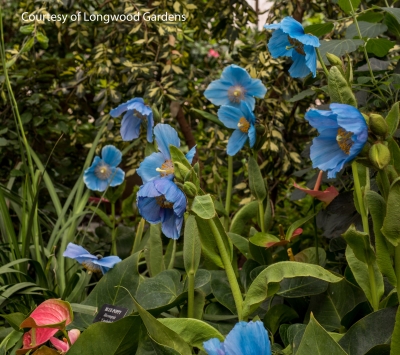
Since then, I’ve lusted for blue poppies but have yet to see the plant in bloom. Twice I tried to grow it, from seed. Each time the seedlings germinated and got off to a good start. Each time, in July, as temperatures here started to get steamy, the plants collapsed, dead. Blue poppy is native above 10,000 feet in the Himalayas and doesn’t like hot weather.
I don’t feel compelled to grow the plant (although that would be nice); I just want to feast my eyes on those bluest of blue petals. To see the plant in bloom requires being somewhere: 1) in late spring or early summer, 2) with cool summers, 3) where blue poppy grows wild or has been planted. The second condition, cool summers, is found in North America in the Pacific Northwest, New England and adjacent parts of Canada, and Alaska. I like hot summers so I’m not relocating to any of these places in order to grow this plant. Also, my garden is particularly needy and entrancing in late spring and early summer, so I’m not leaving then.
I Almost Cross Paths With Blue Poppy, After 20+ Years
As it turned out, I just missed an opportunity to see blue poppy in bloom at Longwood Gardens in Kennet Square, Pennsylvania. Not only is Longwood not far from here, but I happened to be in nearby Philadelphia two weeks ago, when the plant was in bloom. Who would have thought blue poppy could be grown in Pennsylvania?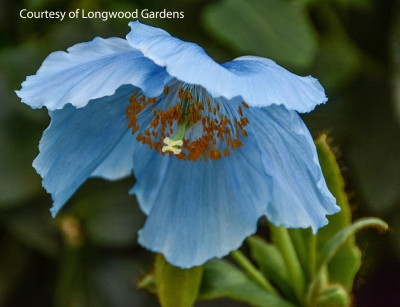 I had, at least, to find out how the plants are grown there. As described by Longwood horticulturalist Jim Harbage, each October Longwood has potted plants shipped from a nursery in Alaska. The plants are put into cold storage until early January, then brought into Longwood’s cool (50-60°F) conservatory to slowly awaken and, finally, blossom in March. After bloom, the plants, although perennials, are discarded.
I had, at least, to find out how the plants are grown there. As described by Longwood horticulturalist Jim Harbage, each October Longwood has potted plants shipped from a nursery in Alaska. The plants are put into cold storage until early January, then brought into Longwood’s cool (50-60°F) conservatory to slowly awaken and, finally, blossom in March. After bloom, the plants, although perennials, are discarded.
Most important is to keep temperatures below 70° F. Research at Longwood Gardens showed that respiration outpaces photosynthesis at warmer temperatures. The plant, essentially, starves. Warmer temperatures also cause some purpling of the petals, ruining the whole reason for growing the plant.
Could Longwood’s prescription be mimicked in my greenhouse? Probably not. Longwood’s large, high-ceilinged conservatory, with dappled shade from tree ferns and citrus trees, perhaps also cooling mists of water puffed into the air as needed, is a lot cooler than my greenhouse. Here, greenhouse temperatures on sunny days in February and March soar, despite vent fans, into the 80s.
How about a sunny window sill? Temperatures are cool in my house, more so the further you go from the woodstove. So that’s a possibility. But purchasing new plants every year could get expensive, especially plants that are good only for compost once their blossoms fade.
How about starting the seeds in early or mid winter for planting outdoors to blossom before temperatures get too hot? Or starting the seeds in fall and exposing the young seedings to very cool temperatures for more assured earlier blossoms outdoors? Blue poppy, if it behaves like many other perennials, should blossom the first season if started very early or if tricked into thinking it’s been through winter before blossoming. I later learned that Chanticleer Garden, also in the Philadelphia region, gets outdoor blossoms from plants purchased in October, wintered in cold frames, then planted outdoors in March. Bloom is in April; composting is in June.
The most important and most reliable route for me to eye blue poppy in bloom is to pencil in a trip to Longwood Gardens for early March next year.
King Red, For Fruit & Beauty, Also Elusive . . . Do Far
My blue poppy experience is reminiscent of my experience with another plant of western Asia, a plant variously called King Red Russian olive, iğde (in Turkey), botanically Elaeagnus angustifolia var. orientalis, or, erroneously, Trebizond date (which is a persimmon species).
King Red is invasive out West but definitely is not invasive here. As with blue poppy, I’ve grown the plant from seed only to have it collapse, dead, when steamy weather arrived.
Beautiful blossoms are not the attraction of King Red, although they do sweetly perfume the air in spring. Rather, it’s the bright red fruit that is highlighted by the gray-green foliage and, when dried, is like sweet talcum powder contained within a cherry-sized, brittle shell. Even without the flowers or fruit, the tree imparts a soft, Mediterranean look to the landscape, much like an olive tree, a relative.
I started some seedlings of King Red Russian olive last year, hoping for some genetic variability in heat tolerance. All the seedlings thrived, probably because of last summer’s relatively cool temperatures.
The seedlings are now dormant in 4 inch pots in my basement. I want 20 foot tall King Red trees so eventually the baby trees need to be planted out. I’m scoping out suitable locations with cooler microclimates. A spot receiving only morning sun is the current best candidate.
Perhaps in a few years I’ll be eating home-grown iğde while enjoying the sight of blue poppies.
HOME GROWN GRAIN & GRAIN-ISH
/0 Comments/in Gardening/by Lee Reich
Popcorn & Chestnuts, Bigger is Better But Not Always
Orville Redenbacker’s popcorn may be an “exclusive kernel hybrid that pops up lighter and fluffier than ordinary popcorn,” but my popcorn — nonhybrids whose seeds I’ve saved for many years — tastes better. I grow two varieties, Pink Pearl and Pennsylvania Dutch Butter Flavored Popcorn.
This winter my popcorns’ poppability was especially poor, probably because of the weather. Really! Popcorn pops when the small amount of water within each kernel, heated above the boiling point, builds up enough pressure to explode the kernel, turning it inside out. For good popping, a kernel needs an intact hull and moisture within. Not just any amount of moisture, though, but as close as possible to 13.5%.
(Other whole grains, such as wheat berries and rice, don’t pop with the same explosive force as popcorn because their hulls are porous.)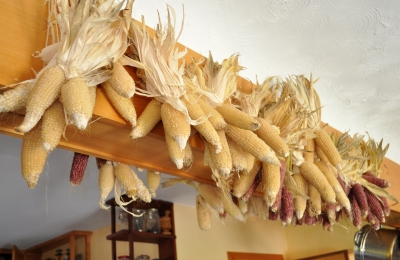
My popcorn spends winter, as ears, hanging from the kitchen rafters. I suspect the kernels are too dry because colder winter weather results in drier air indoors. Cold air holds less moisture than warm air so the colder the outdoor temperatures, the drier the air, once it is warmed.
The kernels need moisture, but not more than 13.5%. Fortunately, for us popcorn lovers, back in 1950 a Mr. Stephen Dexter of Lansing, Michigan came up with an easy way to get the moisture just right, as spelled out in U.S. patent number 2497399. And for those of us who want to start eating our home-grown popcorn early in the season, when kernels may be too moist, his method also sucks excess moisture out of the kernels to bring the level down to 13.5%. Watch out Orville!
Now for the method . . . to quote, “I have discovered that popcorn can be maintained at the best popping condition or restored to that condition by storing it in a closed container in which the atmosphere is maintained at approximately 75% 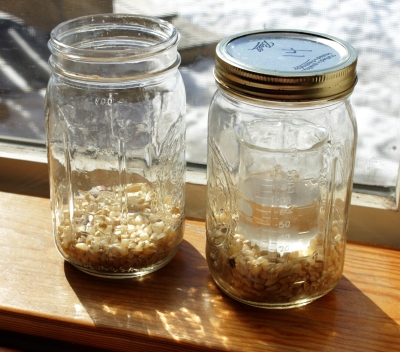 relative humidity. This relative humidity can be maintained throughout a wide range of temperatures by placing in the container a saturated solution of common table salt.” So the first step is to create a saturated solution of salt; I dissolved as much salt as possible (about 1.5 ounces) in a half a cup of water, and then added a little more to make sure that it was saturated.
relative humidity. This relative humidity can be maintained throughout a wide range of temperatures by placing in the container a saturated solution of common table salt.” So the first step is to create a saturated solution of salt; I dissolved as much salt as possible (about 1.5 ounces) in a half a cup of water, and then added a little more to make sure that it was saturated.
It’s important that the popcorn kernels don’t make contact with the salt solution. Mr Dexter maintained the right atmosphere by putting blotting paper soaked in the solution in a sealed container with the kernels. I put the kernels into a Mason jar and then set a beaker with the solution on top of the kernels.
A Little Science, A Lot Better Poppability
Not to doubt Mr. Dexter or the patent process, but the scientist in me had to test the method. A handful of shucked kernels went into each of two Mason jars. One jar was left open to the atmosphere. The other was sealed after I set the beaker of salt solution atop the kernels. Poppability tests came 3 days later. Pennsylvania Dutch Butter Flavored Popcorn, which normally pops pretty well, popped to 1/3 greater volume after the moisture treatment. Pink Pearl awaits testing.
At their best, neither would compare in volume increase with Orville Redenbacher’s popcorn, which claims a 44:1 increase. My popcorn costs nothing except my time (pleasantly spent) and is an organically grown, wholesome, whole grain that hangs decoratively from my kitchen rafter and tastes better. Let Orville have his fluff.
Editing my Chestnut Planting
On to another grain, chestnuts, called the “grain that grows on trees” because, unlike other nuts, it’s low in fat and protein but high in starch. My trees demand little more from me than daily harvest during their two-week ripening period. I have 4 trees but harvest all the nuts I need from one tree, aptly named Colossal for the truly colossal size of the nuts it yield.
Colossal, a hybrid of Castanea sativa (European chestnut) and C. crenata (Japanese chestnut), has its Achilles heel. Make that Achilles heels, plural. The first is that it is susceptible to the chestnut blight that decimated chestnut trees from
Maine to Georgia in the 20th century. Colossal is probably not quite as susceptible to blight as are American chestnuts; my trees, knock on (chestnut) wood, are 17 years old and have never had blight.
More serious is IKB, internal kernel breakdown, which turns the kernels dark and ruins their flavor. IKB occurs in a certain percentage of nuts of European x Japanese varieties when they are pollinated by a Chinese chestnut (C. mollissima) or hybrid. And vice versa. Most of my other trees are Chinese or Chinese hybrids.
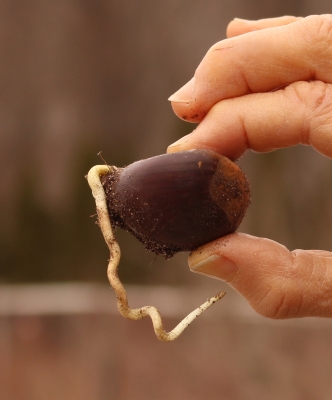 I was going to plant some of my Colossal nuts to make more suitable pollinators for Colossal but, as chestnut researcher Dr. Dennis Fulbright of MSU pointed out to me, those seedlings would have some Chinese “blood” in them. Too bad; I wintered the nuts in a baggie with moist potting soil in my unheated basement. Those nuts now believe that winter is over, and are already sprouting roots.
I was going to plant some of my Colossal nuts to make more suitable pollinators for Colossal but, as chestnut researcher Dr. Dennis Fulbright of MSU pointed out to me, those seedlings would have some Chinese “blood” in them. Too bad; I wintered the nuts in a baggie with moist potting soil in my unheated basement. Those nuts now believe that winter is over, and are already sprouting roots.
I’ll grit my teeth and put the chainsaw to my beautiful, large Chinese and Chinese hybrid chestnuts, and rely on my one, smaller Marigoule chestnut, a European x Japanese hybrid, to offer pollen to Colossal. Marigoule is blight susceptible, so I’m looking to plant another European x Japanese hybrid called Labor Day, which is blight resistant.
At any rate, coming on the heels of winter, it’s nice to see something growing, even if it’s nothing more than a 2 inch root sprout that pushed its way out of a chestnut. Oh, and outside, filbert branches are now draped with catkins, chains of male flowers. And fuzzy, gray catkins have puffed out (indoors, on branches in a vase) on contorted stems of fantail pussy willow. And an abundance of tender green seedling are sprouting in the greenhouse. Happy spring!

